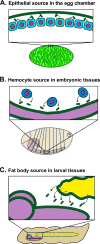Basement membrane mechanics shape development: Lessons from the fly
- PMID: 29656148
- PMCID: PMC6185827
- DOI: 10.1016/j.matbio.2018.04.004
Basement membrane mechanics shape development: Lessons from the fly
Abstract
Basement membrane plays a foundational role in the structure and maintenance of many tissues throughout the animal kingdom. In addition to signaling to cells through cell-surface receptors, basement membrane directly influences the development and maintenance of organ shape via its mechanical properties. The mechanical properties of basement membrane are dictated by its composition, geometry, and crosslinking. Distinguishing between the ways the basement membrane influences morphology in vivo poses a major challenge. Drosophila melanogaster, already established as a powerful model for the analysis of cell signaling, has in recent years emerged as a tractable model for understanding the roles of basement membrane stiffness in vivo, in shaping and maintaining the morphology of tissues and organs. In addition to the plethora of genetic tools available in flies, the major proteins found in vertebrate basement membranes are all present in Drosophila. Furthermore, Drosophila has fewer copies of the genes encoding these proteins, making flies more amenable to genetic manipulation than vertebrate models. Because the development of Drosophila organs has been well-characterized, these different organ systems offer a variety of contexts for analyzing the role of basement membrane in development. The developing egg chamber and central nervous system, for example, have been important models for assessing the role of basement membrane stiffness in influencing organ shape. Studies in the nervous system have also shown how basement membrane stiffness can influence cellular migration in vivo. Finally, work in the imaginal wing disc has illuminated a distinct mechanism by which basement membrane can alter organ shape and size, by sequestering signaling ligands. This mini-review highlights the recent discoveries pertaining to basement membrane mechanics during Drosophila development.
Copyright © 2018 International Society of Matrix Biology. Published by Elsevier B.V. All rights reserved.
Figures


References
-
- Fidler AL, Vanacore RM, Chetyrkin SV, Pedchenko VK, G B, Yin VP, et al. A unique covalent bond in basement membrane is a primordial innovation for tissue evolution. Proc. Natl. Acad. Sci. U.S.A. 2014;111:331–336. doi: 10.1073/pnas.1318499111/-/DCSupplemental/pnas.201318499SI.pdf. - DOI - PMC - PubMed
Publication types
MeSH terms
Substances
Grants and funding
LinkOut - more resources
Full Text Sources
Other Literature Sources
Molecular Biology Databases

